Snowpack Update for Feb 22 2023
Posted on February 22nd, 2023
After a wet past week and bitter cold weather (below zero in Livingston, probably -20 in YNP) snowpack has risen back to over 100% of normal for the date. This is great news. We had been trending steadily downward for the past 6–8 weeks in comparison to normal after a very cold and wet autumn.
We like snowpack to run 100–110% in our main basins (Yellowstone River in Montana and YNP, currently 102% and 104% of normal on the graphic) as of mid-May. This ensures enough water to keep the Yellowstone and its main tributaries like the Lamar, Gardner, Boulder, and Stillwater running high and cold all summer, which keeps the trout happy, but also for them to drop into fishable level and clarity at the normal time in the last week of June or first week of July, which keeps fishermen and guides happy. As of right now, we’re right on track for good conditions this summer.
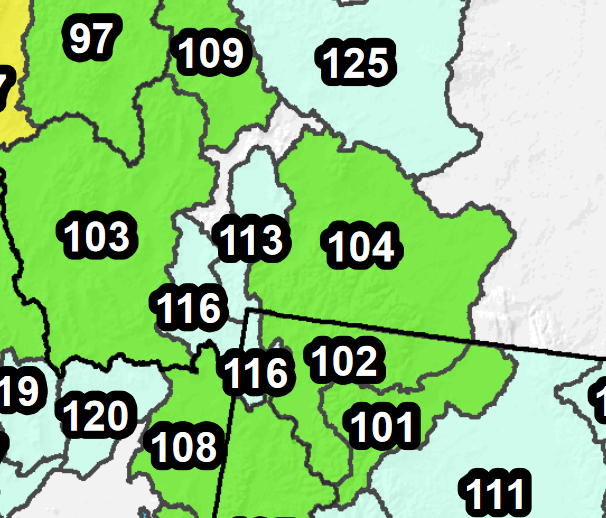
Northwest Wyoming and south-central Montana snowpack numbers for February 22, 2023.
A couple of positive oddities in this map are worth noting.
First off is that the Yellowstone outside YNP is showing higher snowpack than inside the park. Again, 104%. This number actually factors in the snowpack in the upper Yellowstone Basin too, since it all flows downhill. All things considered, the mountains feeding the creeks between Gardiner and Livingston, plus the Shields, Boulder, and Stillwater Basins further east, actually have stronger snowpack than Yellowstone does. Since these basins all suffer from irrigation drawdowns and thus struggle to stay cold all summer, this solid snowpack could really help keep water temps on the Yellowstone east of Livingston cold all summer (no early-out at 2:00PM) and also keep the Boulder and Stillwater floatable will full-size rafts until later in the season. Both these rivers are floatable an extra month in our new ultralight raft (photo courtesy Smithfly) anyway, but the big raft is more roomy and comfortable.
The second oddity is even more exciting. The Madison-Gallatin basin in YNP is at 116% of normal. Usually this basin lags behind the basins further north, primarily because the mountains at the headwaters of the Madison basin in YNP feeding the Firehole and Gibbon Rivers are lower elevation than the ranges elsewhere, meaning the snow tends to skip overhead. The West Yellowstone SNOTEL sensor at relatively low elevation reports a whopping 131% of normal snowpack.
What’s all this mean for the Madison, Firehole, Gibbon, and Gallatin? Well, for right now it means nothing. A big warmup in May and June could melt all that snow in a hurry. That said, if current trends continue, the Firehole, Madison, and Gibbon will have much more cold water entering the system than usual, until later in the summer. Since warm water is the problem in these basins after about June 20, this could lead to a longer late spring fishing season on the Firehole, Gibbon, and Madison in YNP, possibly well into July when we’re usually done fishing this area until late September around June 20–25. Great news for Firehole fans!
If the above numbers hold, we could actually have a fishable Yellowstone, Boulder, and Gardner River at the same time we still have a fishable Firehole and Gibbon. Usually there’s a shaky week in late June or the first week of July when none of the above are prime, and I honestly can’t remember a year when both drainages are prime. Let’s hope this year is the outlier!
Our next snowpack update will drop sometime in the first half of March, especially if a big warmup or a giant storm substantially changes the above numbers. In the meantime, follow the westwide snowpack numbers at this link, which is updated daily. The drainages important to our operations are all near the junction of Wyoming and Montana.
Early February Snowpack Report
Posted on February 5th, 2023
This post is reprinted from our February 1 newsletter. Lots more there if you click!
Winter and spring snowpack and how this snow melts between late April and mid-June are the primary drivers for summer and early fall water conditions in our region (and most of the West). While there can be some surprises, like last year’s intense May and June snowfall followed by intense rain, which led to the June 2022 floods, we like to keep track of snowpack to help our clients start planning summer fishing trips. In general, we like snowpack to run about 110% of normal as of May 10 or so. This is enough extra moisture that it provides a cushion of cold water in late July and August to protect from summer heat waves, while still allowing for a near-normal end to runoff in the first week of July on our prime summer fisheries: the Yellowstone River System including its tributary basins in Yellowstone Park (Lamar and Gardner) and Montana (Boulder and Stillwater).
Our first update of the season is below. We’ll post further updates on our blog around twice a month.
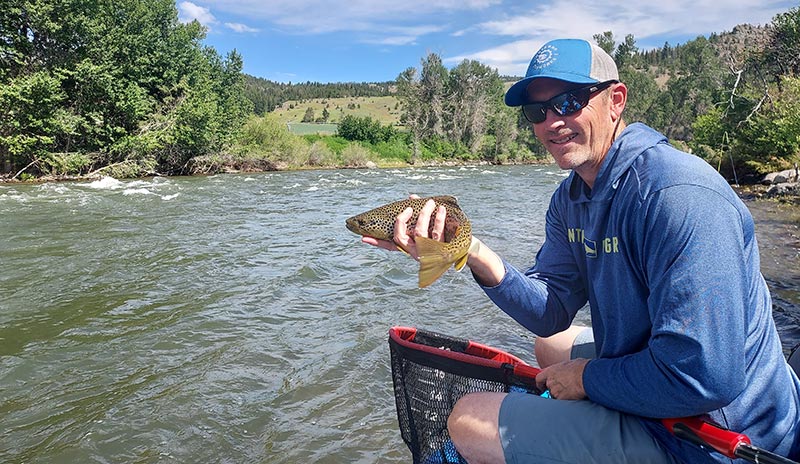 The Boulder River was the most consistent fishery in the area in early July last year.
The Boulder River was the most consistent fishery in the area in early July last year.
We enjoyed a very promising start to winter, with abundant snow and cold temperatures in November and early December. Bridger Bowl ski area opened on time for the first time since 2019 (December 9), and only low staffing kept them from opening in mid-November for the first time in decades. Unfortunately, the snow stopped around Christmas and most of January was exceptionally dry. Only an immense snow storm last week saved January from perhaps being record-dry. Except for an early January blip, temperatures have generally been normal to cold, which is ideal. This puts whatever snow that does fall into a blast freezer and makes for slow melting come May and June, allowing more of the snow to enter the ground water. After the good start, poor late December and most of January, and big storm last week, snowpack in our operations area now ranges from 96% of normal to 127% if normal. These numbers refer to average snowpack for the date, not total snowfall for the entire year.
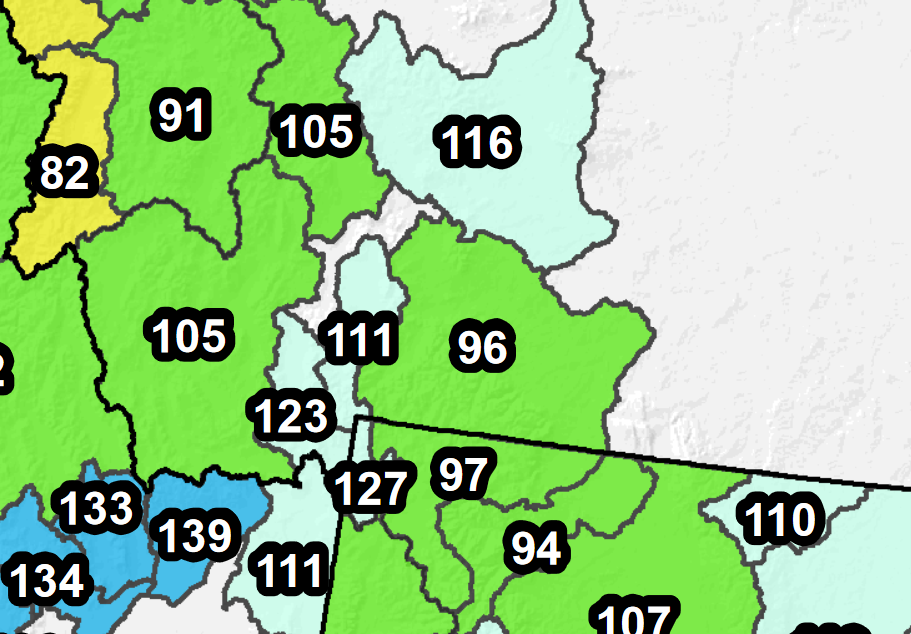
The Madison Basin in YNP is highest, at 127% of normal. This is a nice change of pace which–if it continues–might keep the Firehole and Gibbon Rivers in Yellowstone Park fishing well through June or into July this year. The Yellowstone Basins in Montana and YNP are lowest, at 96% and 97%. Other basins range between the two extremes, but generally run slightly above 100% of normal for the date. As the numbers suggest, we’re generally doing pretty good so far, though we would like the numbers in the Yellowstone Basin to rise somewhat.
The short-term outlooks until roughly mid-February don’t look promising for much more snowfall, but the one-month outlook for February and three-month outlook for February through April look promising.

It’s still early to be making specific predictions on when various fisheries are going to be most productive, but I still try to stare into a crystal ball. With current conditions and predictions for the remainder of winter, I now expect the most consistent fishing on our usual high season fisheries to take place in the latter half of July and first half of August.
Late August conditions will be fine if snowpack remains near to above normal, and as usual September and October fishing depends more on day-to-day weather than it does on snowpack. Extreme drought like we saw in 2021 is not likely. As such, it’s unlikely the Yellowstone system will fish at all between the onset of runoff sometime in early May and at least June 20, with a day or two here and there on the Boulder and Gardner Rivers the only exceptions. The Madison River in Montana, Madison System in YNP, and area lakes will therefore be our primary fisheries in May and June.
If snowpack falls off from current numbers, it is still possible that somewhat-low snowpack will lead to early July being better in the Yellowstone System than late July and early August. That said, overall conditions look at least “within the normal range” so far, which should mean at least decent fishing throughout the high season.
The overall picture presented above will get clearer and clearer as winter and spring progress. Look for another update in mid-February.
Runoff Report and Season Fishing Forecast for Early June 2022
Posted on June 4th, 2022
Introduction, Current Conditions, and Long-Range Outlooks
Here in Yellowstone Country, winter snowpack and how this snowpack melts from late April through June play the most important roles in summer water supply for both fish and agriculture from early June through mid-September. June through mid-September temperatures and rainfall play a secondary role. Only after mid-September does day-to-day weather play the largest role in overall water levels and water quality. Winter and spring weather are thus very helpful in planning summer fishing trips to the region.
On the heels of low snowpack in 2020-2021 followed by a record warm, dry summer that came early and a dry winter, as of April 1 we were mired in severe to extreme drought throughout the region. Thankfully, we have had an exceptionally cool, wet spring that has done a great job in reducing the drought. It’s by no means gone, but conditions have improved. The following graphic shows we’re primarily in moderate drought, with some severe drought in Yellowstone Park. While this isn’t ideal, it’s better than we’ve seen since 2020.
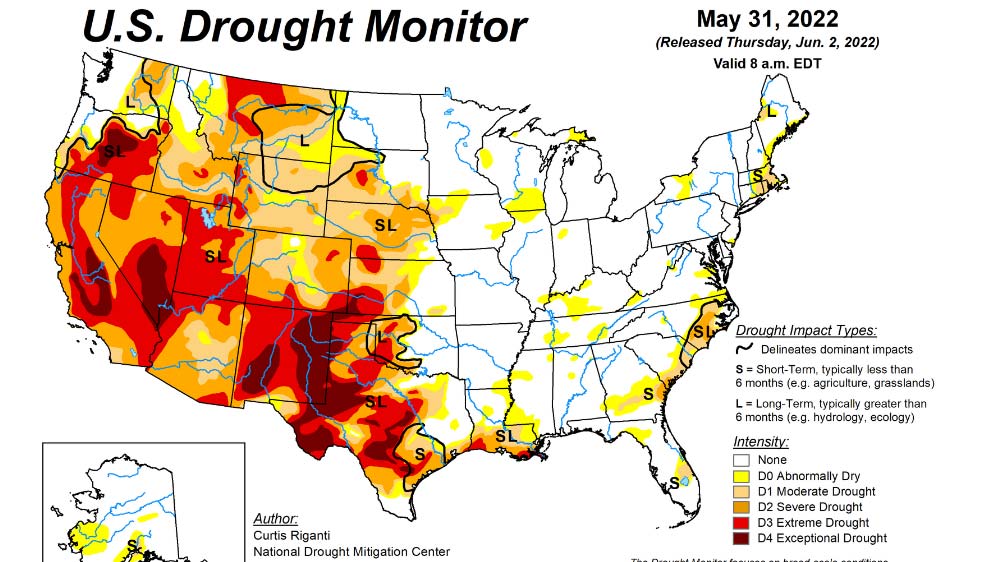
Moreover, snowpack for the date is extremely high. This does not reflect how much snow actually fell this past winter and spring. Instead it shows how much there is on the ground compared to average for this date. Since we’ve had such a cold, wet spring, a whole lot of snow remains to melt. In general, the later and slower the snow melts, the more of it goes into the ground rather than running straight off to North Dakota. Due to the high remaining snowpack and the exceptionally late melt, we expect water levels to be near-average from July through September, even with the drought.
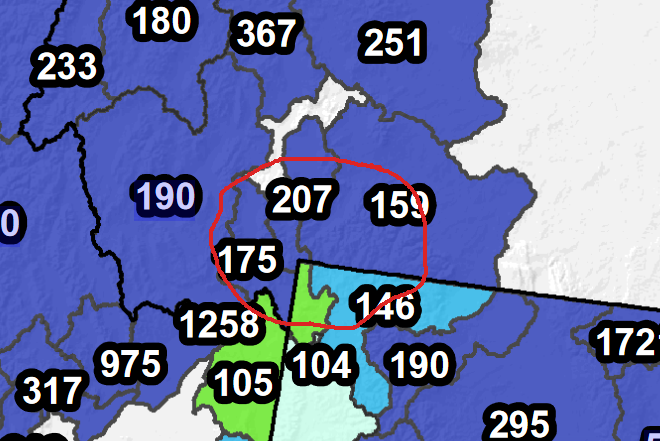
YCFF operations area (roughly) circled in red.
The abundant spring moisture and late melt means that most waters have not yet reached their peak streamflows for the year. On most streams this occurs between May 20 and June 1 in an average year. This year, most waters will reach peak flows in mid-June. Only geyser-heated waters draining low mountains in Yellowstone Park have already reached their peaks. The following graphic shows predicted flows for the Yellowstone River throughout the season. Combined with the graphic above and the weather forecast for the next two weeks, we expect the Yellowstone River to hit max flow around June 13–17. The Yellowstone generally drops into fishable condition about two weeks after it hits peak flow.
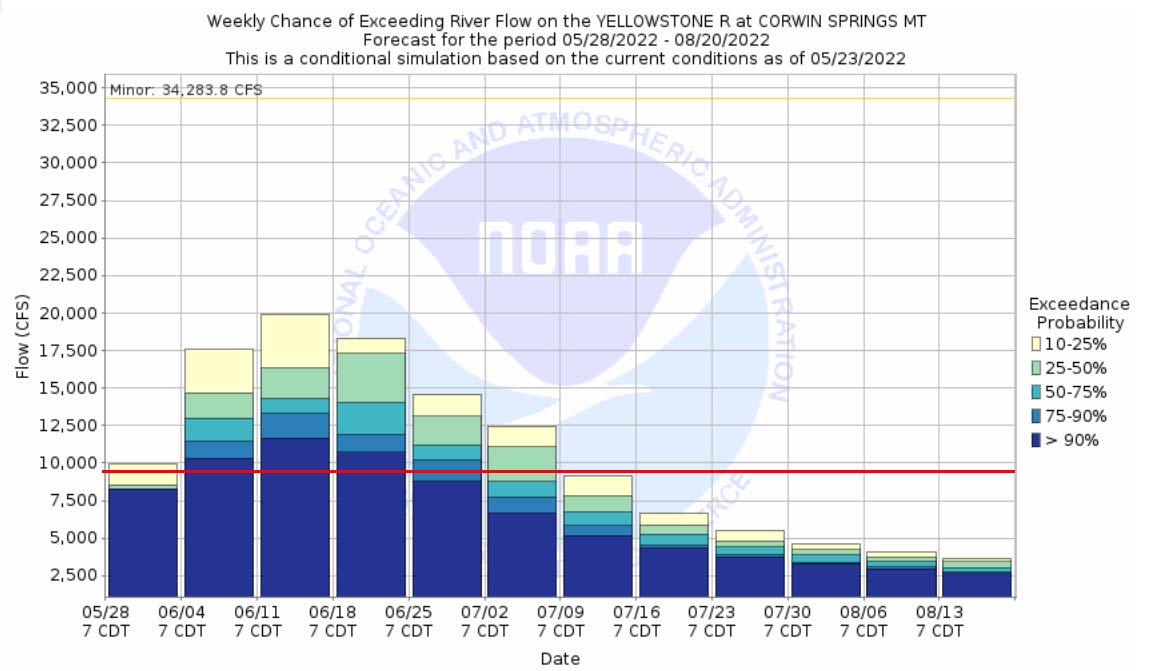
The thin red line indicates the likely flow rate at which the Yellowstone will become fishable this year. This hits the “50/50” prediction for forecast flows around the beginning of July. These forecasts tend to predict slightly higher flows than actually occur, and this forecast was made during a cold/wet spell.
Visit NOAA’s Climate Prediction Center for the full range of long-term outlooks as well as lots of information on ENSO, assorted oscillations, and other weather and climate info that goes right over my head.
Summary of Anticipated Water & Fishing Conditions
In a general sense, here’s what we expect for June through mid-September streamflow and fishing conditions. This is based on current conditions and the longer-range outlooks. While this isn’t a “weather forecast,” it’s now late enough into the year that only extreme, prolonged summer heat and drought will change this forecast substantially for the worse.
- The spring runoff is near its peak. Due to an extremely cold spring, peak snowmelt on all waters is occurring one to three weeks later than average. This is good for late summer flows, not so good for fishing right now.
- After the heavy melt hits and then recedes, the most consistent fishing is likely to occur from about July 4 through sometime in August. Due to the late melt, we DO NOT expect any poor conditions in August and September. It’s fish will just be spookier and more erratic then.
- Near-normal to slightly-below-normal streamflows are now certain, but only after mid-late July. The late runoff means that it is going to take a long time for the water to drop. The late summer low flows will not be extreme and should not have any large impact on the fishing conditions.
- Runoff has been late and will see below-median peak flows on most rivers, but will end on an average to slightly later than average date. The Yellowstone usually drops into fishable shape between June 25 and July 4. This year it will come in around July 1 barring extended late June heat.
- The most consistent fishing will occur in July and early August, but the entire July through October core season should see good water conditions. This is a huge improvement from early spring predictions, when we expected very bad conditions in August and September.
- We do not expect any widespread fishing restrictions due to heat and drought. Only rivers that always or almost always see restrictions (the Lower Madison, Jefferson, Smith, Sun, Shields, and other minor summer fisheries at low elevations in Montana) are likely to see 2:00 fishing closures. On some hot, sunny days in late July and August the late afternoon fishing will be poor, but this is always the case.
- Due to tinderbox conditions throughout most of the West, fires and smoke from both local and distant fires are likely to be very bad this year beginning in late July.
- Due to the winding-down of COVID (we hope) prompting high tourism, as well as the rapidly increasing population in the region, fishing pressure will be intense from the end of runoff through early October, assuming fires and stream closures allow for it. The quality of the fishing will not play any role in how many people are on the water. We are already seeing much more fishing pressure than used to be typical, including record-high bookings for all of spring.
Detailed Fishing Conditions by Water
There have been substantial changes to the following forecasts due to the abundant snow and cold weather we’ve enjoyed in April and early May. In particular, we no longer expect 2:00PM closures in late summer unless we have an extreme heat wave save on rivers that almost always have them, such as the lower Madison River.
Since runoff has now begun in earnest, we are growing much more confident about the accuracy of the following date ranges. If you haven’t booked your lodging or guide service, we suggest doing so ASAP since availability of both is now getting sparse.
Montana Fisheries
- Yellowstone River: Runoff will end between June 25 and July 4, with July 1 most likely. The Salmonfly hatch will occur for about a week immediately after runoff recedes. It is possible the earliest days of the hatch will see conditions too high and muddy to fish. The fishing will be best on slower, shallower sections of river in July and early August, but should be at least fair all season. Faster, deeper water upstream from Livingston should produce well all season. Only record heat and drought in July will change this prediction.
- Madison River: The Lower Madison will not experience any appreciable runoff and will be best prior to July 1. After July 4 it will generally run too warm after noon depending on day-to-day weather. The Upper Madison (really outside my ops area) will likewise probably not experience much of a runoff. It will be best from mid-June through late July.
- Boulder River: Runoff will end late due to intense recent snow. June 25 to July 4 is a reasonable window for the end of the melt, with July 1 most likely. The river will get too low to float by August 1, and perhaps sooner. High water temps and low flows will almost certainly be a problem even for wade-fishing in August due to this small river’s intense irrigation drawdowns. The Boulder seldom sees any fishing restrictions due to water levels or temperature, but in all honesty I expect areas downstream of Natural Bridge should be closed 24 hours a day in August, due as much to irrigation drawdowns as water temps.
- Stillwater River: Runoff will end around July 1 most likely. Upper sections will be too low to float around August 1. Lower portions downstream of the Rosebud confluence will remain high enough to float until at least September 1 and possibly through September. Late summer rains will be required for float-fishing to remain an option after roughly Labor Day. The best fishing will occur in July and August, but should be decent so long as flows remain high enough to allow floating. This river will offer our best “action/numbers/dry flies” fishing this year.
- Missouri River: No appreciable runoff will occur. The carp/walleye/pike water upstream from Canyon Ferry Reservoir will as always fish best from late July through early September. The trout water downstream of Canyon Ferry (including “Land of Giants”) will fish best from now through June.
- Private Lakes: Day-to-day weather is more important on the lakes than snowmelt. These lakes have warmed up very late. Frequently we see excellent hatches in mid–late May. We are still in “leech and streamer mode” due to the cold spring. This late start should keep fishing good well through June, possibly through July in the case of Burns Lake. Hot/bright weather thereafter the determining factor on when things get slow.
- Paradise Valley Spring Creeks: Fishing is always best on the creeks from early March through April, then again from about June 20 through July 20. Unfortunately, radically-increasing pressure on the creeks now means that many prime dates in June-July 2023 are now booked solid. We’re basically done guiding on these creeks except in March-April because of this.
- Other Waters: The Gallatin River will likely drop out of runoff around June 25 and possibly get too warm downstream of Gallatin Gateway by late July. Mountain small streams in Montana will generally fish best from July 15 through August, but may hang on into early September if summer is not too hot and dry. Public lakes in Montana will be best in June except for carp, which rise to hoppers on some lakes in late July and August.
Yellowstone Park Fisheries
- Yellowstone River: The Lake-Falls stretch opens July 1! This is a change from longstanding tradition. For decades this water opened July 15. We wish the early July closure remained in place to let the lake-run cutthroat finish the spawn in peace. That said, early July will almost certainly offer the best fishing here since the mid-1990s, since cutthroat numbers are increasing in general and almost none of them will have migrated back to the lake on the opener, in contrast to the previous opener which saw many fish already moving back to their winter haunts in Yellowstoen Lake. The fishing will remain good through July. The Grand Canyon from the Falls to the Lamar confluence will become fishable around June 20. The most consistent fishing (particularly if you prefer dry flies) will occur in July and early August, though the fishing should remain good until mid-October. The Black Canyon stretch from the Lamar to Gardiner will track similarly to the stretch downstream of Gardiner noted in the previous section.
- Gardner River: The lower Gardner downstream of Boiling River will be fishable on a day-to-day basis from the opening of the park season, joined by the stretch from Sheepeater Canyon to Boiling River around June 20. Consistent fishing will begin by June 25 and continue in both stretches through July and above Boiling River until early October. Below Boiling River will be too warm and weedy at the end of July and on through mid-September. The headwaters above Osprey Falls will come in around July 5–10 and remain good until mid-August.
- Lamar River & Tributaries: Runoff will end sometime in the first ten days of July depending on the water involved and the weather. The best fishing will occur in July and early August. The water will be low and slow and the fish heavily-pressured and spooky thereafter.
- Firehole River: The Firehole will not experience an appreciable runoff and will fish best between the park opener and June 20. The first hot/dry spell after June 20 will shut down fishing until after Labor Day. While conditions have improved in the Firehole drainage over the past few weeks, they’re still not ideal. In fact, snowpack is lower in this basin than anywhere else in the area.
- Gibbon River: The Gibbon upstream of Norris Geyser Basin will be fishable sometime between June 5 and June 10 and will be best before late July. Areas downstream of Norris Geyser Basin are unlikely to experience an appreciable runoff and will be best between the season opener and June 25. After June 25, the first hot spell will shut the fishing off until September 1. We will be guiding here at least two days in the upcoming week.
- Upper Madison River: Generally similar to the Firehole but will hang on for a few days after the first hot spell.
- Lakes in YNP: Ice-out has now happened on all lakes except perhaps Lewis and other high-elevation lakes in the southern part of the park (4+ hours from here). Travel to the lakes before mid-June will be a wet, sloppy mess due to mud and snowmelt. All will fish best through June, then trail off through July.
- Creeks in YNP: Meadow-type streams will become fishable between June 10 and the end of June, with those draining lakes becoming fishable towards the earlier end and those draining mountains falling into shape later. All will be best for the first month after they come in. Rough, mountain creeks will come into shape around the beginning of July and be best for a month to six weeks starting about a week after they fall into shape.